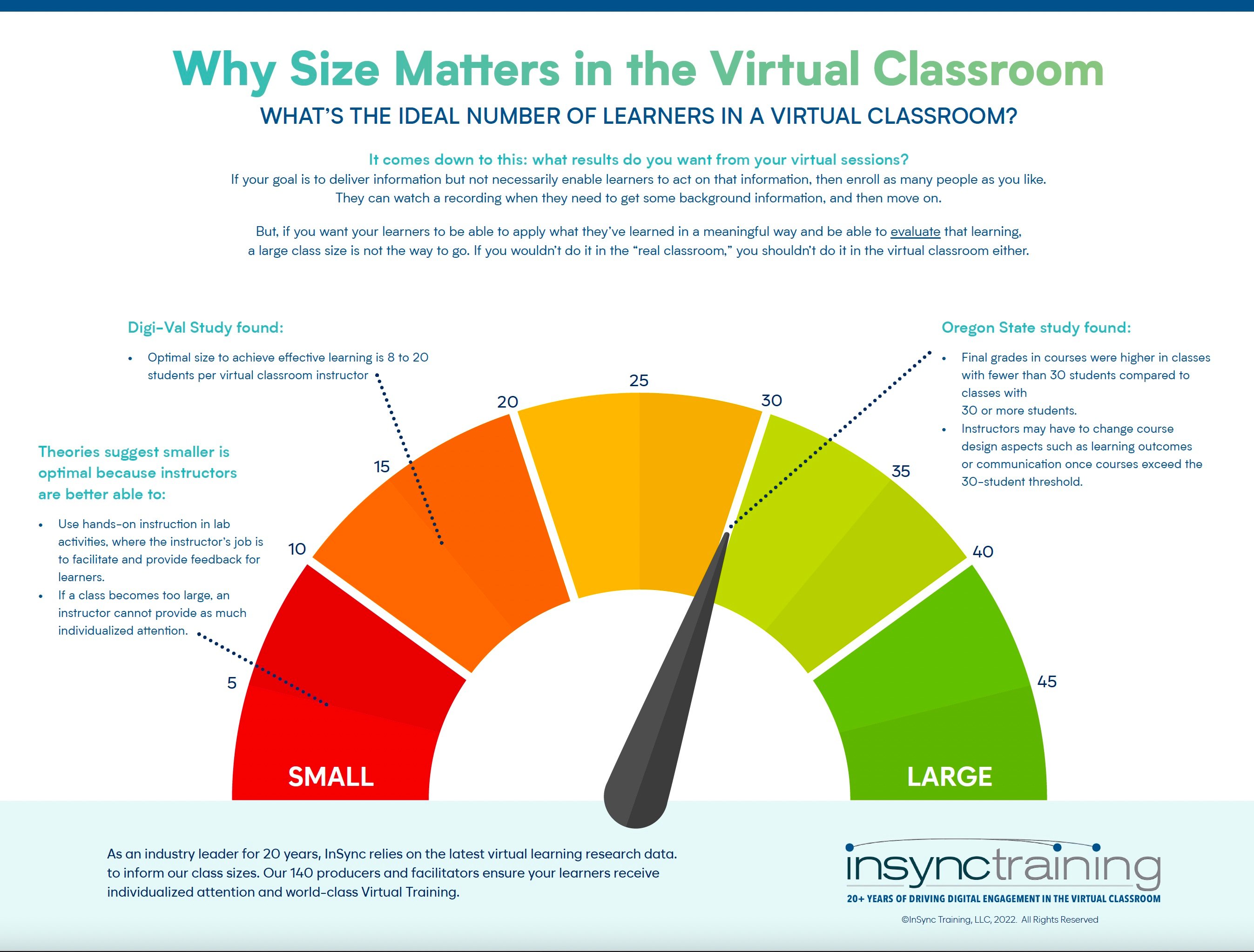COVID 19 Has Changed The Way We Use Virtual Classrooms
What are the Long Term Effects? I remember January. Traditionally, January and February are the slowest months at InSync Training. Organizations tend...
5 min read
 Jennifer Hofmann
:
Jan 6, 2021 11:27:15 AM
Jennifer Hofmann
:
Jan 6, 2021 11:27:15 AM

 Welcome to 2021.
Welcome to 2021.
It seems that everyone is taking a collective breath as we look forward with expectation of promise and insight in a new workplace environment largely mandated by long-term impacts of COVID-19. By the time the pandemic will be deemed “over,” a large fraction of the global developed workforce will have spent nearly two years in work-at-home environments, as many companies are targeting late 2021 for reopening their offices. Some others have rethought their workplace policy altogether. In October 2021, DropBox announced its “Virtual First” strategy - as an ongoing policy “remote work (outside an office) will be the primary experience for all employees and the day-to-day default for individual work.” There is also evidence that employees want some voice in when and how they work from home, seeking a model of “flexible work” that complements, rather than intrudes upon, life at home.[i]
As with most other parts of corporate operations, the corporate training and development community certainly has been impacted – we have seen extensive changes in virtual live delivery, in particular the near-universal adoption of live online technologies to support real-time learning – and, as you might expect, this trend has a dark side – we’re also seeing a trend towards longer virtual programs (> 6 hours in one session). Illustrative is our anecdotal experience supporting corporate clients - in 2019, InSync Training supported less than 20 virtual classroom sessions that were more than six hours long. In 2020 that number approached 1400. This might come as no surprise - organizations with an established training regimen simply “went online” with their materials and training staff, expecting learners to attend in virtual just as if they were in a classroom for eight hours. This practice (among a few others) has resulted in what has become widely known as “Zoom Fatigue”. “Zoom fatigue describes the tiredness, worry, or burnout associated with overusing virtual platforms of communication. Like other experiences associated with the coronavirus (COVID-19) pandemic, Zoom fatigue is widely prevalent, intense, and completely new.”[ii] (A Neuropsychological Exploration of Zoom Fatigue)
2020 didn’t fundamentally change training strategies or organizational training needs; rather, it accelerated a trend. For years, organizations have been discussing moving more and more of their training to a virtual format. It took longer to implement than many would have liked because simply, change is hard. We are all accustomed to the best training programs being implemented in the classroom. Webinars have been considered boring and often a last option when face-to-face wasn’t available.
That’s not our future anymore. While virtual classroom adoption of this magnitude may have taken another decade or more without the pandemic, we are not going backwards. Here at InSync, we expect that 80% or more of the content that has been re-implemented in virtual live instruction will stay there. “Hold on there Sparky” you might be thinking – ‘why would you think that?’ – the answer lies in four key trends that have started this profound change in training delivery:
If employees are planning to split their time between homes, remote offices, and central offices, organizations will need to decide what types of activity should take place in each location. And chances are, learning will largely take place at home offices or with audiences in “mixed environments” – the only way to effectively allow everyone to participate as peer learners is to harness virtual learning (both live and self-paced). Anyone who has ever delivered to a part in-person, part virtual audience knows this – learners need to interact as peers in collaboration and problem solving, which would be vastly different if only some of the audiences are virtual.
In the “before times”, it was a common perception that more rigorous training programs required an in-person classroom experience. Now, with months and months of experience proving that much of this content can be taught effectively in a virtual environment, training programs will be designed for virtual delivery first. Strong arguments will need to be made to justify in-person classes, especially those that include travel related expenses. There will, of course, be strong arguments to be made for some face-to-face programs – especially where collaboration and community building are critical.
As the workforce becomes more virtual, global, and mobile, workers will need to develop skills that help them be successful – for example, fully 63% of sales either start online or will be accomplished with virtual sales, rather than in-person. As training professionals, we can partner with our businesses to not just provide the content they asked for, but to demonstrate the skills required for people to be successful in this interconnected world using virtual technologies and methods.
We really need to consider this experience from the learners’ perspective. (Jane Bozarth talks about this in her November post, Normal. Ish.) In 2020, learners put up with poorly designed virtual classes that went on all day while on video…smiling. It was a lot of work to learn, but learned they did – it was a year like no other, and we all worked hard to make the best of whatever situation we were in. At some point, if things don’t change, and we adapt learning treatments to virtual delivery, it won’t end at “Zoom Fatigue”, it’ll end at “Zoom Attrition” - we’ll just exhaust them into logging off. I’ve said in the past that a lack of design in the virtual environment is much more obvious than a lack of design in the face-to-face environment – instructors can’t just “wing it” based on their presence in the room and the design can’t just present materials – the learner has to be engaged. As an industry, we will need to adopt instructional strategies and techniques that accommodate this “new normal.” (by the way, this is the last time I’ll use the phrase “new normal” in a blog this year – I promise.)
A lot of things might go back to normal. Kids will go to school. We’ll take vacations. We will have meals with our extended families on holidays, and with friends at the local pub on a Tuesday. Some other things will be changed for good – a New York Times opinion piece notes that while workers say they want to go back to work, “people don’t really want to get back to the office. They want to get out of their apartments, their houses, their parents'’ houses. They want their children back in school, and also out of the house. They want to see people’s faces again and have conversations with people who are closer than six feet from them. But that doesn’t mean that they actually want to be back in the office — at least not the way the office was before.” The heavy adoption of virtual training isn’t going away because it is the only approach that allows everyone (wherever they are) to participate in their organizational training, and we should all plan to make it more effective so that organizational training goals can be met without forcing someone to sit at a screen viewing and listening for 8 hours.
Recommended Reading:
Are You Sure You Want to Go Back to The Office? New York Times, December 23, 2020
Coronavirus: How the World of Work May Change Forever BBC, October 23, 2020
[i] According to a recent study by Cisco Systems, almost nine out of 10 workers want to keep some kind of work-from-home setup, often blending remote work and in-office work.
[i] Well, maybe not completely new – InSync and other practitioners with extensive live online experience know that session length should typically be capped at no more than 4 hours, and better in two-hour sessions.

What are the Long Term Effects? I remember January. Traditionally, January and February are the slowest months at InSync Training. Organizations tend...

5 Recommendations to Move Your Training Programs to the Virtual Classroom, and what Virtual Learning Experts™ Need to Know This is part of an ongoing...

As an industry leader for 20 years, InSync continually relies on the latest virtual learning research data to inform our class sizes. Our 140...